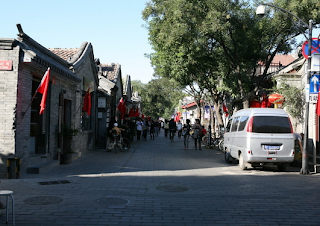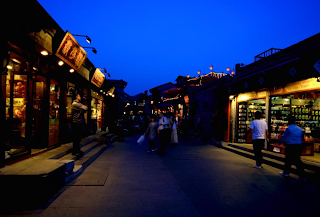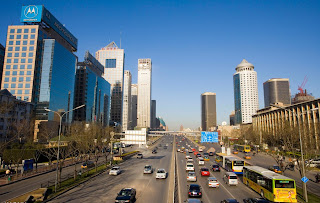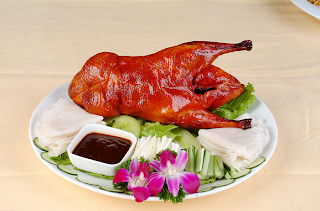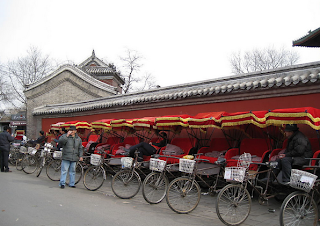In this chapter, we will talk about the old treasure and old fun of Beijingers. At present, more and more old lifestyle of Beijing has been abandoned by youth. If you want to the old trace of this ancient city in China, the
the old treasure and old fun of Beijingers will be a clue for you!
Beijing, Beijing? Old Beijing!
--Old Treasure, Old Fun
--Old Treasure, Old Fun
Old and new Beijing are merged together perfectly. If you want to experience what real Beijing is, then its treasure and fun just in the daily life of Beijingers'.
 |
| The Cartoon of Beijing Opera Roles |
Answers are listed below which will introduce the artistic value of Peking Opera and the funs in Liulichang Antiques Street for you.
● Splendid artistic show of Peking Opera
With its fascinating and artistic accompanying music, singing and costumes, the Peking Opera is China's national opera which gives a profound influence in China and plays a large role in Chinese culture.
Peking Opera is a synthesis of stylized action, singing, dialogue and mime, acrobatic fighting and dancing to represent a story or depict different characters and their feelings of gladness, anger, sorrow, happiness, surprise, fear and sadness.
The singers are accompanied by orchestras made up of traditional Chinese instruments, including two-stringed fiddles erhu and jinghu, lutes, drums and gongs. Plot lines are based on famous myths, well-known stories and historical events. The characters may be loyal or treacherous, beautiful or ugly, good or bad, their images being vividly manifested.
 |
| The Role in Peking Opera |
Therefore, understanding the colors will greatly enhance your enjoyment of the opera as it is an intricate part of the story.--Red faces represent righteousness, black denotes gallantry and heroism, blue and green signify brawn or those held in high regard by commoners, yellow and white are negative colors, often meaning cunning or a tendency to be suspicious, gold denotes deities and silver is reserved for demons or bad spirits. The make-up style indicates if a character is good or evil.
As time goes by, more and more foreigners want to experience this great treasure of China, but the action can be hard for foreigners to follow. Now, some theaters provide English subtitles during the shows and offer abridged versions of operas.
In addition, Several Beijing teahouses also stage scenes from famous operas interspersed with other traditional acts like magic shows, puppetry, and "cross-talk''. Viewing such performances over tea and snacks is a classic Beijing experience. Many visitors likewise enjoy displays of Chinese martial arts and acrobatics, which are regularly held in local theaters.
● Overwhelming Fun in Liulichang Antiques Street
Being endowed with so many Chinese ancient treasures, Beijing Colored Glaze Factory Culture Street (Liulichang Antiques Street) really deserves a visit to experience the Hutong culture in Beijing.--It is a symbol of traditional Chinese culture. It´s known as a treasure trove of traditional Chinese culture.
 |
| Liulichang Antiques Street |
Walking along Liulichang Xi Jie is like strolling through a living museum, the hutong filled with shops selling antiques and antique reproductions, kites, drums, posters, Chairman Mao memorabilia, contemporary paintings and more.
On Liulichang Xi Jie, there are many oldest and the most famous shop and enterprise where you can have a glimpse of the old style and features of old Beijing.
The most famous emporium is Rongbaozhai (19 Liulichang Xi Jie), which for years has specialized in supplies for the scholar, gentleman and artist. These includes ink stones-shallow basins in which ink blocks are mixed with water-calligraphy brushes, seals, paper and scrolls.
Then Cathay Bookshop( 57 Liulichang Xi Jie) is an exhibit of photography of pre-Revolutionary Beijing, ancient maps, old books and more.
All the street is a good place for you find out whatever interesting souvenir of Beijing and sometimes you can really get good deal there. The Liulichang Antiques Street runs the spectrum from kitsch to truly collectible, are shadow puppets, ceramics, Peking opera masks, Buddha statues, paper lanterns, swords, opium pipes, paintings and more.
--The real old Beijing and its great fun can't share to you in just one passage and different people have different ways to enjoy themselves. Thus, why not get general ideas from this small passage of old Beijing's treasure of Peking Opera and Old Beijing's most interesting hutong Liulichang Antiques Street and then plan for a real trip to get close to all of these fascinating funs?

